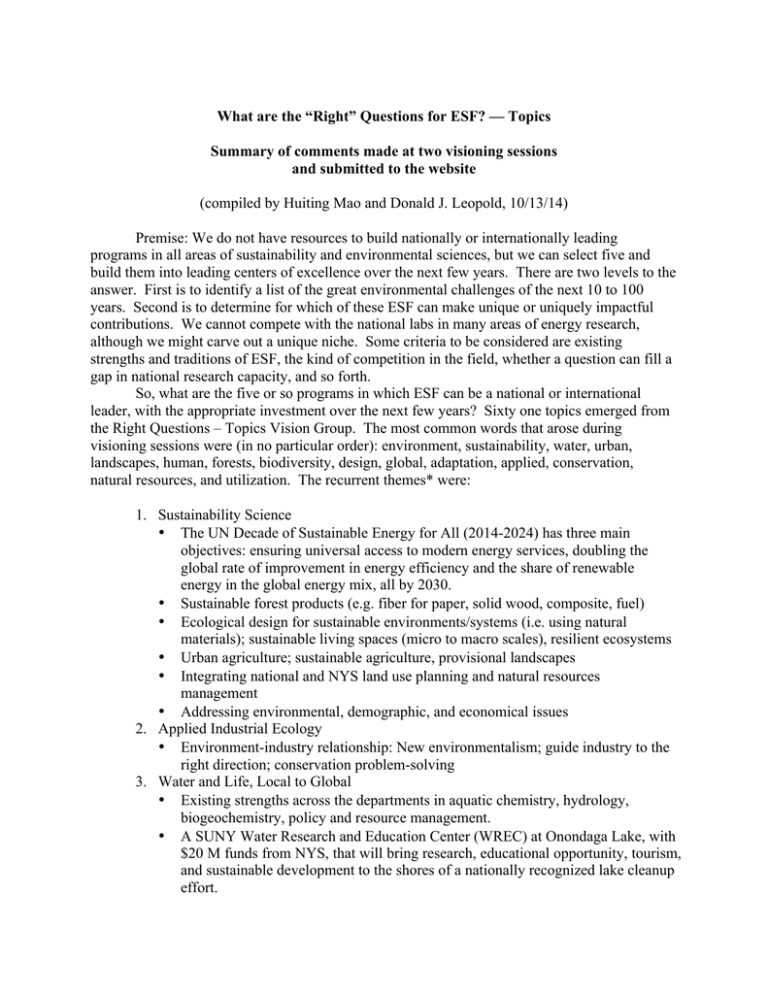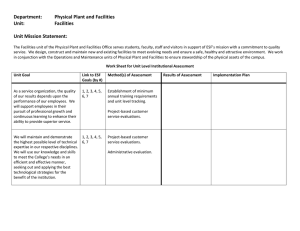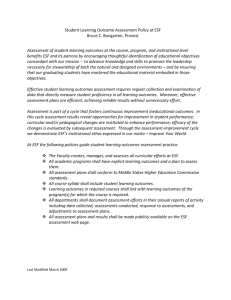What are the “Right” Questions for ESF? — Topics
advertisement

What are the “Right” Questions for ESF? — Topics Summary of comments made at two visioning sessions and submitted to the website (compiled by Huiting Mao and Donald J. Leopold, 10/13/14) Premise: We do not have resources to build nationally or internationally leading programs in all areas of sustainability and environmental sciences, but we can select five and build them into leading centers of excellence over the next few years. There are two levels to the answer. First is to identify a list of the great environmental challenges of the next 10 to 100 years. Second is to determine for which of these ESF can make unique or uniquely impactful contributions. We cannot compete with the national labs in many areas of energy research, although we might carve out a unique niche. Some criteria to be considered are existing strengths and traditions of ESF, the kind of competition in the field, whether a question can fill a gap in national research capacity, and so forth. So, what are the five or so programs in which ESF can be a national or international leader, with the appropriate investment over the next few years? Sixty one topics emerged from the Right Questions – Topics Vision Group. The most common words that arose during visioning sessions were (in no particular order): environment, sustainability, water, urban, landscapes, human, forests, biodiversity, design, global, adaptation, applied, conservation, natural resources, and utilization. The recurrent themes* were: 1. Sustainability Science • The UN Decade of Sustainable Energy for All (2014-2024) has three main objectives: ensuring universal access to modern energy services, doubling the global rate of improvement in energy efficiency and the share of renewable energy in the global energy mix, all by 2030. • Sustainable forest products (e.g. fiber for paper, solid wood, composite, fuel) • Ecological design for sustainable environments/systems (i.e. using natural materials); sustainable living spaces (micro to macro scales), resilient ecosystems • Urban agriculture; sustainable agriculture, provisional landscapes • Integrating national and NYS land use planning and natural resources management • Addressing environmental, demographic, and economical issues 2. Applied Industrial Ecology • Environment-industry relationship: New environmentalism; guide industry to the right direction; conservation problem-solving 3. Water and Life, Local to Global • Existing strengths across the departments in aquatic chemistry, hydrology, biogeochemistry, policy and resource management. • A SUNY Water Research and Education Center (WREC) at Onondaga Lake, with $20 M funds from NYS, that will bring research, educational opportunity, tourism, and sustainable development to the shores of a nationally recognized lake cleanup effort. • Ecotoxicology, environmental health • Environmental geospatial analytics 4. Biodiversity and Natural History • Species and landscape conservation and restoration • Existing strengths in biology, environmental studies • Natural products • Environmental ethics, policy 5. Scientific Literacy, Environmental Communication • Citizen science 6. Climate Change Mitigation and Adaptation • Mitigation of global warming: Sequestering CO2 in the built environment through timber engineering and construction for sustainable systems • Existing strengths in biology, water, coastal, landscape ecology, design, to address climate adaptation issues • Tree restoration, new organisms for the future • Biomimicry Other suggestions: 1. Creative visions are needed for increasing the visibility, reach and effectiveness of the diverse creative energies that are represented among the faculty. These visions are demanded by the digital revolution in higher education. 2. Education • The mission of ESF education is not only training of scientists, but a majority of our students with Bachelor and Masters degrees have joined the work force and become foresters and natural resource managers. We should acknowledge and strengthen the many programs across our campus that produce these exceptional environmental/resource managers. • Build a center around the value of our field properties • Enhance undergraduate research through programs such as REU • Global environmental leadership training & global partnerships 3. Determine relationship between different themes and their integration 4. Consolidate departments *an attempt was made to objectively group similar ideas into themes; one can review the many specific ideas suggested at the Sept. 24 and Oct. 1 visioning sessions, and posted separately on the web site at: http://www.esf.edu/strategicplan/#anchorvision


